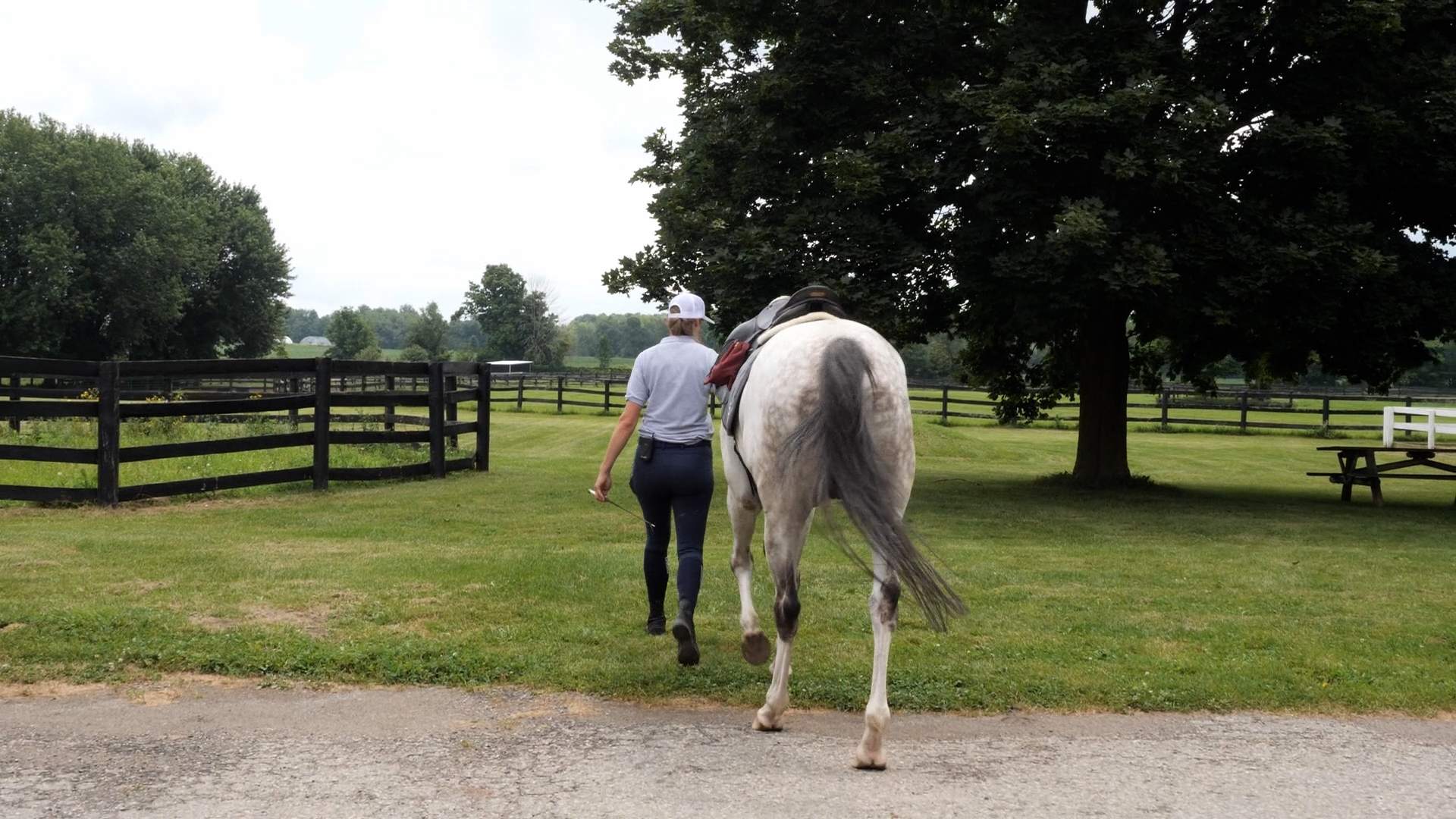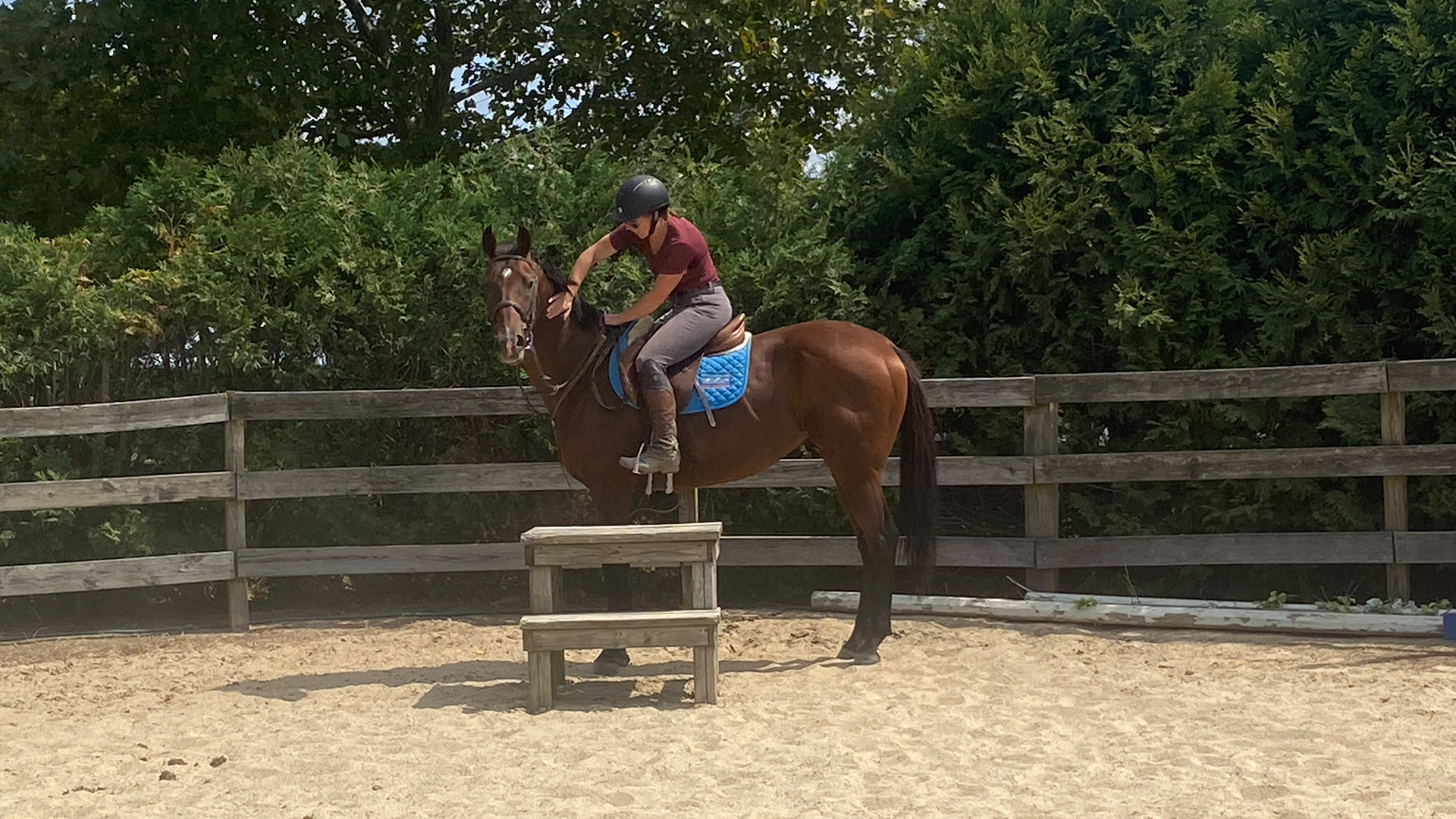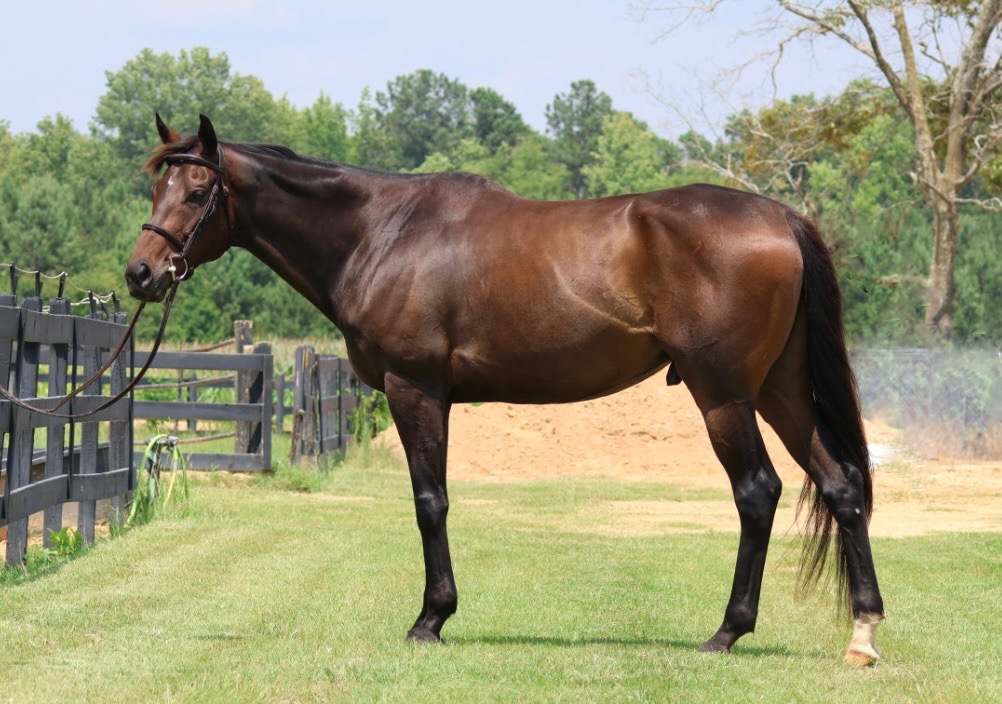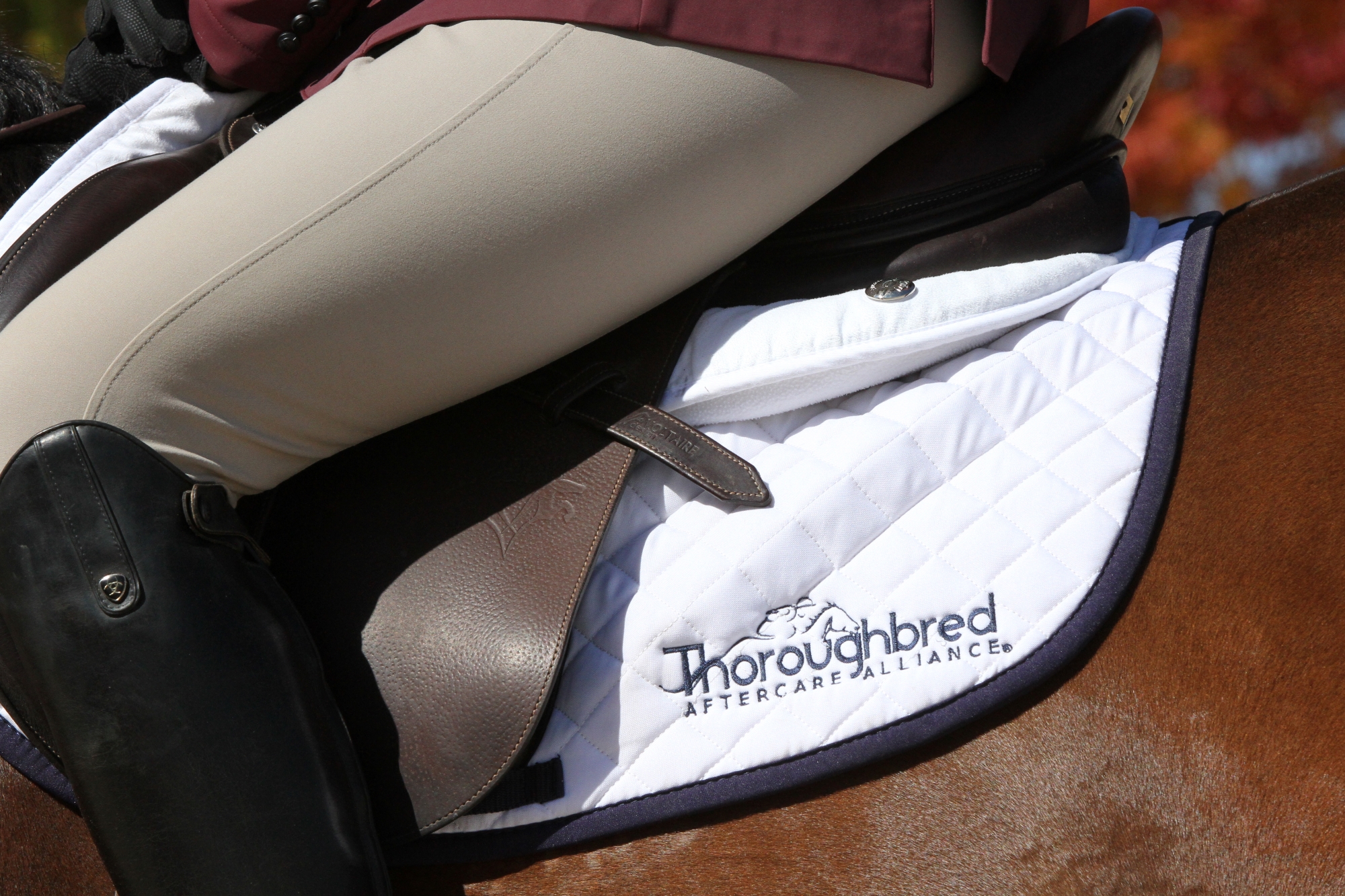Retraining
All Posts & News Press Releases Success Stories Aftercare Editorials Retraining Tips Supporter Features Equine-Assisted Learning Inspector Spotlights Hamburger Toggle Menu Previous Post Getting Started with Groundwork and Manners for Your Ex-Racehorse Getting Started with Groundwork and Manners for Your Ex-Racehorse By: Alexis Arbaugh April 11, 2025 Retraining Tags:Accredited Organization, Groundwork, LongRun Thoroughbre, Manners, Retraining, Thoroughbred Aftercare Alliacne Lauren Millet, LongRun Thoroughbred Retirement Society Thoroughbred Aftercare Alliance recently had the pleasure of speaking with Lauren Millet, the trainer at LongRun Thoroughbred Retirement Society, about her approach to retraining ex-racehorses. Based in Toronto, Canada, LongRun is a Thoroughbred Aftercare Alliance-accredited organization dedicated to the rehabilitation, retraining, and adoption of retired Thoroughbred racehorses. Growing up, Lauren frequented the racetracks in Canada and hoped that one day she would have a job working with racehorses. Years later, Lauren became the Farm Manager at LongRun, where she oversees the training and riding of all the horses that enter the facility. Her role involves assessing the training of each horse and building upon their foundation. Additionally, she evaluates each horse once the retraining process begins to determine the most suitable second career for them. “Groundwork in racehorses totally varies based on where they come from, who their groom was and what they were allowed to do at the racetrack,” writes Lauren. Nearly all racehorses are hand-walked almost daily from the time they are weaned, which instills good manners and ensures they walk confidently and respectfully beside their handlers. However, Lauren notes that most ex-racehorses are not taught the following: “how to move away from pressure, back up when asked, step over or around obstacles, stand in crossties or tied outside.” The life of a racehorse is quite different from that of a sport horse, so they’re taught different skills from an early age to help them succeed in their specific careers. “They [racehorses] are taught the things that they need to know at the track, such as: how to tie in a stall, lead to the left, pick all 4 feet from the left side etc.,” Lauren says. She encourages people to recognize the importance of understanding what that specific horse was taught on the track, as it directly influences how they should be trained off the track. At LongRun, horses arriving directly from the racetrack will either require rehabilitation with stall rest or benefit from a period of downtime before beginning their retraining program. “If a horse is on stall rest, obviously in-hand manners cannot be tested, but we do look for stall manners,” Lauren comments. Observing whether a horse respects your presence or shows signs of any bad behavior when you enter their space can be crucial in determining what to focus on during stall rest. It is the person’s job to show and teach the horse what you want from them. “With some it is easy, while others might be annoyed and irritated that they are on stall rest,” notes Lauren. She is essentially saying that there is a limited number of things that you can teach a horse while in a stall, but you can teach them to respect your space and to move away from pressure. For horses that retire sound from the track and only need downtime, it’s easier to assess their groundwork and manners. Each horse will require a varying amount of downtime before beginning their retraining. Lauren feels that you can learn a great deal about a horse based on their behavior while walking to and from the pasture, “this gives us a chance to see which horses might require some ground to learn respect before jumping into the saddle and which horses might be good to go”. Teaching a horse to walk over poles, back up, and move away from pressure are essential skills for riding. Therefore, starting with groundwork—regardless of the horse’s prior training—provides them with a solid foundation and helps ensure the safety of both you and the horse. “It just helps to ease their confusion when learning all the new things at once,” Lauren expresses. “Once they understand, it makes for a much happier time for both horse and human.” Lauren Millet LongRun Thoroughbred Retirement Society Once a horse has completed their rehabilitation or downtime, it’s time to focus on skills that will assist them in their second career. Lauren mentions that it usually becomes clear what kind of retraining a horse will need after they’ve been on the farm for a couple of days. Horses that arrive at LongRun with prior handling and riding experience typically transition more smoothly, as they already have a head start. In contrast, those with less experience require additional time to learn the basics before formal retraining can begin. “Many racehorses carry tension, and it’s important to teach them right away to let that go,” observes Lauren. She emphasizes the importance of ensuring that all horses are comfortable in their own bodies and able to move freely and without stress. Teaching a horse to remain relaxed and not feel tense can be challenging; it requires a significant amount of patience and understanding from the trainer, especially during the initial stages. “The goal is to teach the horse that whatever the encounter, their response should be to remain calm and think about what they are doing,” Lauren emphasizes. Horses are intelligent and eager to please, but it’s essential to clearly demonstrate to the horse what behaviors are acceptable and which are not. “If you let them [horses] take an inch, they will take and mile,” writes Lauren. It’s important to kindly discipline a horse when they exhibit undesirable behavior and to praise them when they do something you approve of. A horse will remember the discipline and will be less likely to repeat the behavior that got them in trouble. Conversely, when a horse is praised for doing the right thing, they are likely to remember that positive reinforcement and want to replicate the behavior to receive more praise. Establishing clear ground rules from the beginning is
Read More >All Posts & News Press Releases Success Stories Aftercare Editorials Retraining Tips Supporter Features Inspector Spotlights Hamburger Toggle Menu Previous Post The First Ride The First Ride By: Alexis Arbaugh April 3, 2025 Retraining Tags:MidAtlantic Horse Rescue, Mounting, Mounting Block, Retraining, Retraining Tip, Thoroughbred Aftercare, Thoroughbred Aftercare Alliance Aint Wasting Time’ first ride The first ride on a recently retired Thoroughbred racehorse can be quite daunting, especially for those new to it. Even experienced riders might find it intimidating. These horses are fresh off the racetrack, often highly muscled, fit, and powerful—qualities that make them incredibly fast and strong but also a bit overwhelming for immediate riding. Most owners give their retired racehorses a break before starting any retraining. This downtime allows the horse to relax, adjust to its new environment, and lose some of that racetrack muscle. It is crucial for starting the retraining process with a clean slate. Thoroughbred Aftercare Alliance had the pleasure of speaking with Beverly Strauss, one of the co-founders of MidAtlantic Horse Rescue in Chesapeake City, Maryland, about the first ride off the racetrack. MidAtlantic, a Thoroughbred Aftercare Alliance-accredited organization, cares for more than 45 horses across their main facility and satellite farms. They work closely with racetracks to take horses directly off the track and rescue them from auctions and feed lots. Once the horses arrive, they are carefully evaluated for rideability, trained, and placed into adoptive homes. In addition to her aftercare work, Bev and her husband run a small Thoroughbred racing business at Delaware Park. With her extensive knowledge both on and off the racetrack, Bev is a highly skilled horsewoman who ensures the best outcomes for all her horses. “One of the great things about OTTBs is the solid foundation that most of them have,” Bev wrote. Many are already well-versed in walking, jogging, cantering, galloping, and automatically changing leads, both independently and in groups. These young Thoroughbreds are exposed to a lot of commotion during early morning workouts and race days, learning to stay relaxed even in busy environments. Whether they race for ten years or not at all, they come away highly desensitized. There are a few key similarities between racehorse riding and sport horse riding. In both disciplines, riders must have excellent balance, whether perched atop the horse or with their legs securely wrapped around its barrel, and maintain a quiet, steady hand. Bev points out that the mindset is also often the same—if a horse gets “spicy,” the rider laughs it off and pushes the horse forward, making sure not to let the horse get away with anything. Just like training racehorses, there are various approaches to retraining them. Some trainers prefer groundwork, while others, like Bev and her team at MidAtlantic, prefer to hop right on without any groundwork. However, before riding, they ensure the horse is sound, eats well, and is maintaining a healthy weight—key factors that indicate the horse is ready to start work. Much of the tack used on the racetrack is similar to what you’ll use when retraining. Since this will be a new experience for the horse, keeping familiar elements can help them feel more at ease. At MidAtlantic, they prefer to start all their horses in a D snaffle with a lozenge in the middle. The D snaffle is the same as on the track. On the track, D snaffles typically have one joint, while off the track, they often have two joints. Both bits are gentle, but double-jointed snaffles are the softest, making them ideal for horses starting a new career. At MidAtlantic, they also use a very loose running martingale on all their horses, as it’s similar to a yoke and rings. A running martingale provides more control by applying pressure and preventing the horse from raising its head too high. While a yoke with rings is typically made of nylon rather than leather, it serves the same purpose. Although English and jockey saddles differ in size, they generally sit in the same spot on the horse’s back, so there is little difference in how it makes the horse feel. Aint Wasting Time’s first ride Some trainers prefer the intimacy of working in a round pen, but Bev has a different approach. “I personally don’t like riding in a round pen because there isn’t much room, and it’s hard for the horse to balance, always being on a turn,” she explains. She also points out the limited space to regain control if the horse becomes unruly. Instead, Bev starts all their horses in an arena, which offers more space for free movement and helps the horse feel less confined. Bev also rarely lunges a horse before the first ride, only “if the horse acts girthy or uncomfortable, but only maybe one or two times out of over 100 first rides.” MidAtlantic places a strong emphasis on using voice cues during the first few rides. Depending on how much and what kind of training the horse had previously, their understanding of leg pressure will vary. For instance, a horse that was hacked as a youngster might already have an idea of what leg pressure means. “Smooching or clucking helps while they learn what the leg means,” Bev writes. Another common issue is the horse’s ability to steer, which also depends on their prior training. For example, a horse that was long-lined will typically have better steering skills. The mounting block is often a foreign object to a racehorse, and it can take time for the horse to get used to it. At MidAtlantic, they use a large, three-step wooden block positioned on a curve, away from the wall. This setup allows the horse to be placed between the block and the fence, creating a barrier to keep the horse still. Some horses are unfazed by the block, while others might be wary and avoid it. “In those cases, we’ll sit on the block and chat until the horse relaxes and approaches it,” Bev says. Ain Wasting Time’s
Read More >All Posts & News Press Releases Success Stories Aftercare Editorials Retraining Tips Supporter Features Inspector Spotlights Hamburger Toggle Menu Previous Post Ulcer Care and Stress Management Tips for Off-Track Thoroughbreds from Second Wind Ulcer Care and Stress Management Tips for Off-Track Thoroughbreds from Second Wind By: Alexis Arbaugh February 20, 2025 Retraining Tags:Colic, Retraining Story, Retraining Tip, Second Wind, Second Wind Thoroughbred Project, Thoroughbred Aftercare Alliance, Ulcers Important Note: The following is based on the experience and practices of Second Wind Thoroughbred Project, as shared by founder Dayle Eldredge. This information should not be construed as professional veterinary advice. It is always recommended to consult with a veterinarian for the proper diagnosis and treatment of your horse’s health conditions. Thoroughbred Aftercare Alliance had the pleasure of speaking with Dayle Eldredge, the founder and president of Second Wind Thoroughbred Project, located in Bethune, South Carolina. Since 2015, Second Wind has specialized in the rehabilitation, retraining, adoption, and sanctuary of retired Thoroughbred racehorses. With their extensive experience in handling numerous horses daily, they have refined their approach to managing ulcers and reducing stress, which plays a key role in preventing ulcers and colic. The methods they use are rooted in observation, experience, and a commitment to the horses’ well-being as they transition from racing to their new careers. Strollanothertime (First Arrives) Photo provided by Dayle Eldredge Dayle explained their digestive health protocol begins when a horse first arrives at Second Wind from the racetrack. Dayle notes they assume any horse coming to their program from a racetrack will likely have ulcers. They have learned there is a difference in the types of ulcers– gastric ulcers, which occur in the stomach, and hindgut ulcers, located further down the digestive tract. Dayle often looks for symptoms of ulcers such as poor coat condition, a lack of appetite, difficulty eating hay, sensitivity to grooming around the belly, girthing issues, or cribbing. Nutrition is a key part in the way Second Wind manages their Off-the-Track Thoroughbreds’ digestive health. Each horse is fed a specific diet. “We feed a high fat grain, but less than most people would think is ’normal’. We feed 1/3 scoop ([which amounts to] about 2.5 pounds total) and add 3 scoops soaked alfalfa cubes and beet pulp, and they are fed this 3 times a day,” Dayle described the diet. “It is not easy to quantify how many pounds of soaked beet pulp and alfalfa cubes it is, as it depends on how much water is used. But it should be soaked at least one hour prior to feeding.” These ingredients are nutrient-dense and support weight gain, which is particularly important for Thoroughbreds who may struggle to maintain weight, especially when dealing with ulcers. In addition to the feed regimen, supplements and ulcer medications also play a key role when a horse first arrives from the track. Dayle explained an important part of Second Wind’s ulcer management includes GastroGard (Omeprazole), which is an equine gastric ulcer treatment. Each horse that arrives is also started on a three-month course of Succeed, a digestive supplement designed to promote and maintain digestive health. Dayle explained, “If [GastroGard] is in your budget, you can start with that for 30 days and then follow up with Succeed for 60-90 days.” Dayle emphasized that minimizing stress is key to preventing both ulcers and colic. At Second Wind, horses are turned out 24/7, except in extreme cold or heat. In these cases, they are brought into large stalls where hay is available at all times. Dayle explained that constant access to forage is essential for preventing ulcers, as it buffers stomach acid. Without sufficient forage, stomach acid can irritate the stomach lining and lead to ulcers. Temperature fluctuations are also an important factor in managing stress. If horses are exposed to cold and wet conditions or extreme heat, it can lead to stress, which can contribute to weight loss and potentially exacerbate ulcers or lead to colic. Dayle and her team carefully monitor weather conditions, using high-velocity fans in hot weather and ensuring horses stay dry and comfortable in cold or wet conditions. Maintaining a low-stress environment and making sure the horses have access to fresh water and ample alfalfa all help prevent colic, a common concern among racehorses transitioning into new environments. When horses come to Second Wind from the racetrack, they are often used to a highly structured routine, and the transition to a new environment that is a bit more relaxed can be overwhelming. “Many people think that just because the horse gets to live a more laid-back life that they will be happier, and in time, they are, but the adjustment period is crucial to their mental and physical health,” Dayle explained. Dayle observed that many racehorses spend very little time outside during the racing season, often only hand-grazed between training sessions. The sudden shift to 24/7 turnout can be a big adjustment, and not all horses handle the change in the same way. Some thrive with the new freedom, while others need time to adjust. Dayle carefully observes each horse to see how they respond to the new routine. Strollanothertime – Photo provided by Dayle Eldredge “Learning about the horse and what makes them happy is going to help everyone in the long run,” Dayle wrote. “We do try to give each horse what makes them comfortable, and slowly integrate them into our routine.” Dayle Eldredge Second Wind Thoroughbred Project If a horse appears anxious or doesn’t settle well into 24/7 turnout, Dayle brings them inside and ensures they have at least one other horse nearby for companionship. She believes that understanding each horse’s unique personality and needs is key to a smooth transition. “Learning about the horse and what makes them happy will help everyone in the long run,” she shared. At Second Wind, the health and comfort of each horse are a top priority. Their comprehensive approach to ulcer and colic prevention combines dietary management, the use of supplements and medications,
Read More >All Posts & News Press Releases Success Stories Aftercare Editorials Retraining Tips Supporter Features Inspector Spotlights Previous Post How to Teach Your Retired Racehorse to Jump How to Teach Your Retired Racehorse to Jump By: Alexis Arbaugh June 6, 2024 Retraining Tags:Friends of Ferdinand, hunter jumper, hunters, jumper, jumpers, Jumping, Retraining Tips, show jumping Alien Invasion – Photo provided by Lori Miller Lori Miller, Friends of Ferdinand Many people who adopt a Thoroughbred after it is retired from racing hope to train their horse for a second career, often in disciplines that involve jumping. Training a Thoroughbred to jump can be a brand-new experience for these retired athletes, as racehorses—unless experienced in steeplechase—don’t engage in jumping or even handling poles. Their primary focus is running on the flat and being trained for speed. Therefore, it can be challenging to teach an off-the-track Thoroughbred how to carefully and skillfully navigate a course of jumps. Lori Miller is the head trainer at Friends of Ferdinand, an organization accredited by Thoroughbred Aftercare Alliance. Located in Indianapolis, Indiana, Friends of Ferdinand specializes in retraining, rehabilitation, adoption, and providing sanctuary homes for Thoroughbreds retired from racing. Lori has extensive experience with racetracks and retired racehorses and takes pleasure in the retraining process, knowing that racehorses can have happy and healthy lives in new careers. Lori’s wealth of experience and knowledge makes her the perfect person to help fellow adopters navigate their new horse’s retraining process. It is difficult to determine if a horse will be a good jumper just by looking at them, as there are many factors to consider and different contexts for evaluation. “If you are at the track, it’s tough. A horse that races in blinkers or wears a shadow roll might be one that has a lot to think about,” Lori wrote. Horses that need to wear blinkers to focus generally have excess energy and are spooky. Lori generally tries to avoid spooky horses because it creates more problems when teaching them to jump. “I prefer the horses that will walk with confidence through whatever,” Lori wrote. Lori also considers conformation when assessing whether a horse would be good at jumping. She likes horses that seem to float when they travel, rather than stomp. She avoids horses with crooked legs, tiny feet, or a downhill build. Instead, she looks for horses that are balanced with an uphill build and correct angles. She prefers straight legs that allow the horse to stand under themselves and a neck that ties in high to their shoulders. Although there are outliers—horses with unconventional conformation that make wonderful jumpers—they are few and far between. A horse with a good attitude is always easier to work with than one that is grumpy or has a poor attitude. When asked about the kind of attitude or temperament she looks for, Lori replied that she seeks “the horse that wants to work with you, the horse that looks to the person rather than away”. A horse that wants to learn and seeks guidance from people is always going to excel. However, it is easier to evaluate a horse’s willingness after they have had a chance to settle down on a farm following their racing career. It usually takes some time after leaving the track for a horse to come out of its shell and show its true personality. “How they are at the track is frequently very different than they are away from home,” Lori wrote. Any horse that is friendly and easy to work with and around is a good start. “I want the horse to learn to go over what is put in front of it. Systematically by never asking it to do something we haven’t built up to. Teaching the horse to stay in a rhythm and not run, that there is no reason to get tight and anxious. I want my horses to learn it’s all positive”. Lori Miller Friends of Ferdinand So, now that you have your horse, how do you start jumping? Lori begins with basic flat work to ensure the horse is supple and responsive to the bit. She encourages the horse to move forward off the leg and be quick and accurate with transitions, ensuring the horse is always listening. After establishing a strong flat foundation, she introduces poles on the ground, having the horse casually walk, trot, and canter over them until they are no longer an issue. She wants the horse to get used to riding around standards, poles, and jumps in the arena, encouraging them to watch and continue working. When Lori feels the horse is ready to jump, she starts with a small jump that the horse can easily walk over. If the horse stops in front of the jump, she breaks it down to make it more inviting. “Slow work to build a confident horse,” Lori wrote. By this point, the horse is accustomed to going over poles and small boxes, so a small cross rail shouldn’t be a big deal. Their first actual jump might be a cross rail or a small log in the field, and the horse shouldn’t be fazed by it. Desensitizing your horse to various obstacles helps prevent stress or nervousness about jumping. When asked what Lori would like the horse to take away from their first jumping experience, she replied, “I want the horse to learn to go over what is put in front of it. Systematically by never asking it to do something we haven’t built up to. Teaching the horse to stay in a rhythm and not run, that there is no reason to get tight and anxious. I want my horses to learn it’s all positive”. Lori often trots over fences in the beginning stages of teaching a horse to jump. This allows the horse to learn to make a shape and stay straight while building confidence at a slower and more balanced pace. She advises against over-jumping young horses or those learning to jump, limiting
Read More >
















